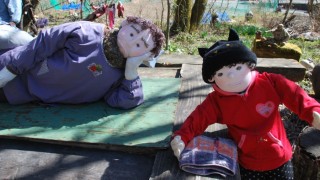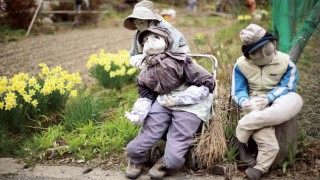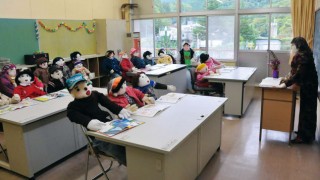Loading
Search
▼ Valley Of The Dolls: Inside Japan's 'Scarecrow Village'
- Category:Tourism
Nagoro, Japan (CNN) — On the surface, Nagoro is like any other sleepy riverside village in southern Japan's remote Iya Valley.
A winding drive through the small town appears to reveal elderly residents tending to their gardens and families waiting patiently at a bus stop. It all seems normal... until you realize that most of those "people" aren't people.
They're life-sized scarecrows -- and they outnumber the human residents ten-to-one.
The cotton-stuffed oddities are the brainchild of Tsukimi Ayano, a crafts hobbyist who returned to the village in 2002 after living in Osaka for most of her life.
What started as a functional scarecrow creation (made in her father's image) to deter birds from pilfering seeds from the family plot has morphed into an ongoing creative, memorial-like project. Today, hundreds of scarecrows are spread around the village -- and international visitors have found out about it.
"I never expected people from all over the world to come to this small village," says Ayano, speaking to CNN Travel from inside her classroom-like scarecrow workshop space.
As an isolated valley town in the less-trodden Japanese island of Shikoku, Nagoro is difficult to reach -- buses are infrequent and the nearest train station is an hour away -- but it hasn't deterred the 3,000 or so people per year who visit, a few of whom return annually.
Times have definitely changed for Nagoro, similar to the plight of other Japanese villages with aging populations.
In Ayano's childhood years, there were more than 300 residents, including families with young children.
Today, there are 27 residents; the youngest is over the age of 50. Ever since Ayano's return to Nagoro in 2002, many of the older residents, including her next-door neighbors, have passed away, while the younger ones moved to Japan's larger towns and cities en masse for better economic opportunities. Ayano came up with the idea of creating effigies of former residents as a way of memorializing them while infusing some spirit into the vanishing village.
Soon after making the first few scarecrows for practical farmland purposes in 2003, she created one in the likeness of a late neighbor she used to talk with every day, so that she could "speak" to her like old times.
As more villagers passed away or relocated, she began creating more neighbor-esque scarecrows (a three-day process per doll) in remembrance of their presence.
"Before the scarecrows, it was just an ordinary village no one really cared about," Ayano says.
That remained mostly true even after the scarecrow displays arrived, until a visiting German filmmaker, Fritz Schumann, did a short documentary in 2014 on Ayano's work, titled "Valley of Dolls," attracting global attention and intrigue to an unassuming hamlet in the Tokushima prefecture.
The village's only school was shut down a few years ago as the last two elementary students graduated.
What would have been an abandoned building is now an unofficial "museum" of students, teachers, parents and imaginary figures. There's a classroom of 12 or so attentive, wide-eyed pupils at their desks as the teacher delivers a lesson.
A large, airy gymnasium features scarecrows that Ayano and other people have made, lined along the perimeter of its walls. On the gym's stage is a bridal party wearing customary Western and Japanese clothing and, inexplicably, six short boys wearing potato sacks stand next to the formally dressed bunch.
Those really into the scarecrows can memorialize themselves, or someone else, with Ayano's Scarecrow-Making Workshop, held every fourth Wednesday each month from April to November (bring your own sewing set and scarecrow clothing). It's here where she reveals the materials used: wooden slabs for the base, cotton clumps for the head, elastic fabric for the skin, buttons for the eyes, wires and around 80 rolled newspaper pages for each doll's "skeleton".
There's also the annual Scarecrow Festival, a foreigner favorite which happens every first Sunday of October.
And if Ayano is available on other dates, people can visit her home to see her most special creation: an effigy of her deceased mother, who watches over Ayano with graceful eyes in the living room. Ayano speaks to her daily.
When asked if she ever plans to leave Nagoro and return to Osaka in the future, Ayano says, "The reason why I came back was to take care of my father. If I get sick or old, I might go live with my children or other family in Osaka. But as long as I'm healthy, I'd like to stay in Nagoro, and continue making the scarecrows."
This is great news for visitors and the existing residents who enjoy the scarecrows' presence, as the scarecrows last just three years before needing replacement. With her sustained Nagoro residency, Ayano will continue to breathe life into a fading village, one stuffed doll at a time.
A winding drive through the small town appears to reveal elderly residents tending to their gardens and families waiting patiently at a bus stop. It all seems normal... until you realize that most of those "people" aren't people.
They're life-sized scarecrows -- and they outnumber the human residents ten-to-one.
The cotton-stuffed oddities are the brainchild of Tsukimi Ayano, a crafts hobbyist who returned to the village in 2002 after living in Osaka for most of her life.
What started as a functional scarecrow creation (made in her father's image) to deter birds from pilfering seeds from the family plot has morphed into an ongoing creative, memorial-like project. Today, hundreds of scarecrows are spread around the village -- and international visitors have found out about it.
"I never expected people from all over the world to come to this small village," says Ayano, speaking to CNN Travel from inside her classroom-like scarecrow workshop space.
Effigies of past residents
As an isolated valley town in the less-trodden Japanese island of Shikoku, Nagoro is difficult to reach -- buses are infrequent and the nearest train station is an hour away -- but it hasn't deterred the 3,000 or so people per year who visit, a few of whom return annually.
Times have definitely changed for Nagoro, similar to the plight of other Japanese villages with aging populations.
In Ayano's childhood years, there were more than 300 residents, including families with young children.
Today, there are 27 residents; the youngest is over the age of 50. Ever since Ayano's return to Nagoro in 2002, many of the older residents, including her next-door neighbors, have passed away, while the younger ones moved to Japan's larger towns and cities en masse for better economic opportunities. Ayano came up with the idea of creating effigies of former residents as a way of memorializing them while infusing some spirit into the vanishing village.
Soon after making the first few scarecrows for practical farmland purposes in 2003, she created one in the likeness of a late neighbor she used to talk with every day, so that she could "speak" to her like old times.
As more villagers passed away or relocated, she began creating more neighbor-esque scarecrows (a three-day process per doll) in remembrance of their presence.
"Before the scarecrows, it was just an ordinary village no one really cared about," Ayano says.
That remained mostly true even after the scarecrow displays arrived, until a visiting German filmmaker, Fritz Schumann, did a short documentary in 2014 on Ayano's work, titled "Valley of Dolls," attracting global attention and intrigue to an unassuming hamlet in the Tokushima prefecture.
Scarecrow workshops
During a visit, one can see scores of scarecrows going about their daily lives outdoors: construction workers with hard hats "installing" a road sign; an affectionate couple sat on tree stumps watching the gurgling river; a wellington boot-wearing fisherman taking a break on his front porch with his young daughter alongside him; and several coat and hat-clad adults assuming different gardening roles that look uncomfortably real.The village's only school was shut down a few years ago as the last two elementary students graduated.
What would have been an abandoned building is now an unofficial "museum" of students, teachers, parents and imaginary figures. There's a classroom of 12 or so attentive, wide-eyed pupils at their desks as the teacher delivers a lesson.
A large, airy gymnasium features scarecrows that Ayano and other people have made, lined along the perimeter of its walls. On the gym's stage is a bridal party wearing customary Western and Japanese clothing and, inexplicably, six short boys wearing potato sacks stand next to the formally dressed bunch.
Those really into the scarecrows can memorialize themselves, or someone else, with Ayano's Scarecrow-Making Workshop, held every fourth Wednesday each month from April to November (bring your own sewing set and scarecrow clothing). It's here where she reveals the materials used: wooden slabs for the base, cotton clumps for the head, elastic fabric for the skin, buttons for the eyes, wires and around 80 rolled newspaper pages for each doll's "skeleton".
There's also the annual Scarecrow Festival, a foreigner favorite which happens every first Sunday of October.
And if Ayano is available on other dates, people can visit her home to see her most special creation: an effigy of her deceased mother, who watches over Ayano with graceful eyes in the living room. Ayano speaks to her daily.
When asked if she ever plans to leave Nagoro and return to Osaka in the future, Ayano says, "The reason why I came back was to take care of my father. If I get sick or old, I might go live with my children or other family in Osaka. But as long as I'm healthy, I'd like to stay in Nagoro, and continue making the scarecrows."
This is great news for visitors and the existing residents who enjoy the scarecrows' presence, as the scarecrows last just three years before needing replacement. With her sustained Nagoro residency, Ayano will continue to breathe life into a fading village, one stuffed doll at a time.
- July 25, 2019
- Comment (0)
- Trackback(0)




